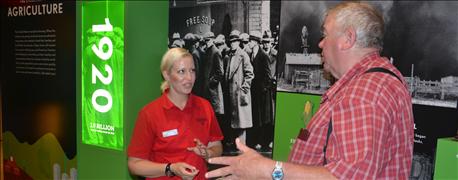
Jamie Miller took us partway through the Fair Oaks Farms Crop Adventure yesterday. Now Miller, attractions manager at Fair Oaks, is ready to continue the tour. The Crop Adventure exhibit is sponsored by WinField.
“When I first heard the idea for a ‘Crop Adventure,’ I was concerned if it would be interesting,” Miller admits. "It's been open only since early summer, but I’m not concerned now. Young and old alike, people find it entertaining and educational."
Stop 1. Discover a real farmer through the magic of technology.

PREPARE FOR GUIDED TOUR: Attractions manager Jamie Miller (left) tells Tom Bechman, the author, what lies ahead on the tour through Fair Oaks Farms' Crop Adventure, sponsored by WinField.
Master Farmer Del Unger stands in his soybean field and talks about crop production and efficient use of water in a short video that repeats over and over. His Sullivan County farm includes a large portion of sandy land, with much of it now irrigated. Unger's talk is at the beginning of a section about how farmers produce food today.
Stop 2. Learn about the importance of water and other topics through interactive displays.
Visitors naturally gravitate to an interactive information board about water. Another board nearby discusses why farmers use herbicides, and how they make them most effective. It even introduces the subject of adjuvants, showing leaves sprayed with and without adjuvants in the spray tank.
Stop 3. Corn grows at the exhibit.
This corn is growing inside an environmentally controlled growth chamber. Note all the lighting built in to supply light for corn. The goal of this area, Miller says, is to introduce people who don’t know much about growing corn to what modern corn production is all about.
Stop 4. Big kernels represent increased yield — and fun for kids!

CORN GROWS INDOORS: Visitors get to see growing corn up close and personal in this portion of the tour.
What better way to illustrate how much yields have increased per acre since the 1920s, where this tour began, than by displaying a graph showing yields moving up next to a toy elevator that actually works and moves giant corn kernels into the bin. Anyone young at heart will take a turn at the crank of this old-fashioned elevator. Nostalgia meets the future in this display.
Stop 5. Follow soybeans from field to end use.
Even farmers can spend 15 minutes studying this display board and learn something they didn’t know about soybeans. The varying routes soybeans can follow once they leave your farm and where they can end up are clearly outlined.
Stop 6. Learn how wheat winds up as flour.
You may grow wheat and haul it to town, but you may never think about it when you eat a sandwich made with two slices of bread. This display tracks what happens to wheat before it ends up in your sandwich.



BIG KERNELS, BIG YIELDS: If you’re a kid at heart, you won’t be able to resist cranking the elevator and moving the huge kernels into the grain bin.
FOLLOW THE CROP: Have you ever thought about exactly what happens to soybeans (left) once they leave your farm? Or how wheat (below) winds up as flour used in breads and cakes, and what processes it goes through? These displays depict the various ways these crops are processed and used.
About the Author(s)
You May Also Like




